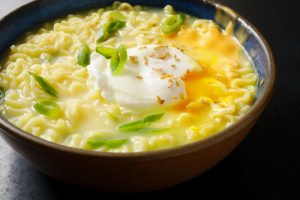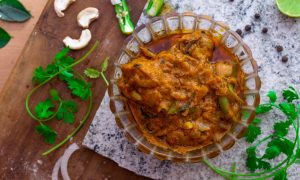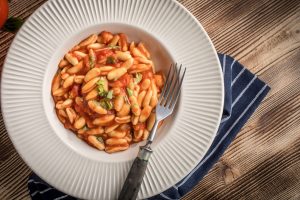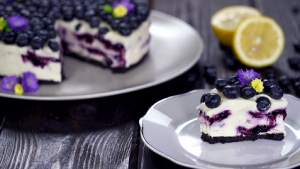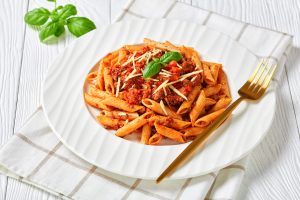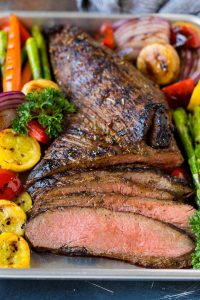Embrace the flavors of Thailand with this Thai Chicken Ramen recipe. It's a hearty, comforting dish that combines tender chicken, vibrant vegetables, and the rich creaminess of coconut milk, all in a spicy, savory broth. This dish is all about balance - the heat from the curry paste, the tang from the lime juice, and the sweetness from the coconut milk. It's a quick and straightforward recipe that brings the authentic Thai taste to your kitchen.
Some of the ingredients in the recipe might not be commonly found in your pantry, such as Thai green curry paste and fish sauce. These can be found in the Asian section of most supermarkets or in Asian grocery stores. The Nissin Raoh Umami Tonkotsu flavor seasoning also might be in the Asian food aisle.
Ingredients for Thai Chicken Ramen
Vegetable oil: Used as the base to sauté the vegetables and helps to release the flavor from the green curry paste.
Red bell pepper: Adds a sweet, mild flavor and a crunch to the soup.
Matchstick carrots: They add color, sweetness, and vitamin A to the dish.
Green onions: They give a mild, oniony flavor.
Thai green curry paste: This is what gives the soup its spicy, aromatic Thai flavor.
Water: Used as the base for the soup.
Light coconut milk: Adds a rich, creamy texture and sweet flavor to the soup.
Fish sauce: This adds umami and a salty depth of flavor.
Nissin Raoh Umami Tonkotsu flavor: Adds rich, umami flavor to the soup.
Chicken breast: The protein of the dish, chicken is lean and absorbs the flavor of the soup well.
Lime juice: Adds acidity and brightness to balance the rich flavors.
Cilantro: Adds a fresh, herbaceous flavor.
Unsalted peanuts: Adds a nice crunch and nutty flavor.
Sesame seeds: They add a subtle crunch and nutty flavor.
One reader, Garek Barringer says:





This Thai chicken ramen recipe is a game-changer! The blend of flavors is simply divine, and the creamy coconut milk adds a delightful richness. The combination of tender chicken, crunchy peanuts, and zesty lime juice creates a burst of deliciousness in every bite. It's a must-try for any ramen lover!
Key Techniques for Crafting Thai Chicken Ramen
How to sauté vegetables: Heat oil in a large pot over medium-high heat. Add the bell pepper, carrots, and 3 of the green onions, then sauté for 1 minute.
How to incorporate curry paste: Add Thai green curry paste and sauté for 1 minute longer.
How to cook ramen: Stir in the water and coconut milk and fish sauce, then bring the mixture to a boil. Add in ramen, cover the pot, and boil for 4 minutes, stirring once halfway through.
How to prepare seasoning: Add the seasoning packets from ramen to a bowl. Ladle out 1 cup of the water mixture from the soup, then stir into seasonings in the bowl, and return to the pot.
How to shred chicken: Stir in the shredded chicken, lime juice, and ¼ cup of cilantro.
How to serve: Divide among 4 bowls, then top with more cilantro, remaining green onion, peanuts, and sesame seeds. Serve and enjoy!
How To Make Thai Chicken Ramen
Creamy coconut milk, shredded chicken, and veggies make up this hearty chicken ramen! It’s also packed with peanuts and sesame seeds for a slight crunch.
Serves:
Ingredients
- 1tbspvegetable oil
- 1red bell pepper,thinly sliced, diced into 1½-inch pieces
- 1cupmatchstick carrots
- 4green onions,divided, sliced
- 1tbspthai green curry paste
- 4cupswater
- 14ozlight coconut milk,(1 can)
- 1tbspfish sauce
- 3.53ozNissin RAOH Umami Tonkotsu Flavor,(2 packages)
- 10ozchicken breast,cooked, shredded
- 1tbsplime juice,fresh
- ½cupcilantro,roughly chopped, divided
- ⅓cupunsalted peanuts,chopped, optional
- 1tspsesame seeds,optional
Instructions
-
Heat oil in a large pot over medium-high heat. Add the bell pepper, carrots and 3 of the green onions, then sauté for 1 minute.
-
Add Thai green curry paste and sauté for 1 minute longer. Stir in the water and coconut milk and fish sauce, then bring mixture to a boil.
-
Add in ramen, cover the pot, and boil for 4 minutes, stirring once halfway through.
-
Add seasoning packets from ramen to a bowl. Ladle out 1 cup of the water mixture from soup, then stir into seasonings in bowl then return to pot.
-
Stir in the shredded chicken, lime juice, and ¼ cup of cilantro.
-
Divide among 4 bowls then top with more cilantro, remaining green onion, peanuts and sesame seeds. Serve and enjoy!
Nutrition
- Calories: 338.82kcal
- Fat: 23.79g
- Saturated Fat: 8.24g
- Trans Fat: 0.10g
- Monounsaturated Fat: 8.46g
- Polyunsaturated Fat: 4.18g
- Carbohydrates: 11.00g
- Fiber: 3.24g
- Sugar: 5.71g
- Protein: 19.40g
- Cholesterol: 45.73mg
- Sodium: 476.43mg
- Calcium: 63.83mg
- Potassium: 491.56mg
- Iron: 1.88mg
- Vitamin A: 336.21µg
- Vitamin C: 44.88mg
Crucial Technique Tip for Thai Chicken Ramen Success
When cooking the ramen, it's important to not overcook it as it can become mushy and lose its texture. To ensure it's cooked perfectly, try tasting a noodle after the 4-minute mark. If it's still a bit firm in the center, it's done. Remember, the noodles will continue to cook slightly in the hot broth even after you remove it from the heat.
Time-Saving Tips for Thai Chicken Ramen Recipe
Prep ahead: Chop vegetables and measure out ingredients in advance to streamline the cooking process.
One-pot wonders: Opt for recipes that require minimal dishes and cooking utensils to reduce cleanup time.
Multitask: While one component is cooking, use that time to prep other ingredients or clean up to maximize efficiency.
Efficient tools: Utilize kitchen gadgets like food processors and mandolines to speed up prep work.
Leftovers makeover: Plan for leftovers and repurpose them into new dishes to save time on future meals.
Quick swaps: Substitute ingredients with pre-prepped or store-bought options to cut down on prep time.
Batch cooking: Prepare large quantities of staple ingredients like grains and proteins to use in multiple dishes throughout the week.
Substitute Ingredients For Thai Chicken Ramen Recipe
vegetable oil - Substitute with coconut oil: Coconut oil can add a rich, tropical flavor to the dish, complementing the Thai-inspired ingredients.
red bell pepper - Substitute with yellow bell pepper: Yellow bell peppers have a slightly sweeter flavor and can add a pop of color to the dish.
matchstick carrots - Substitute with julienned zucchini: Zucchini can provide a similar crunch and texture to the dish while adding a subtle, fresh flavor.
green onions - Substitute with chives: Chives have a mild onion flavor and can be used as a garnish to add a pop of color and freshness to the dish.
Thai green curry paste - Substitute with red curry paste: Red curry paste can provide a similar depth of flavor with a slightly different spice profile.
water - Substitute with chicken broth: Chicken broth can add extra richness and depth of flavor to the broth of the ramen.
light coconut milk - Substitute with unsweetened almond milk: Unsweetened almond milk can provide a creamy texture and a subtle nutty flavor to the dish.
fish sauce - Substitute with soy sauce: Soy sauce can add a savory, umami flavor to the dish, similar to fish sauce.
Nissin Raoh Umami Tonkotsu flavor - Substitute with fresh ramen noodles: Fresh ramen noodles can provide a more authentic and chewy texture to the dish.
chicken breast - Substitute with tofu cubes: Tofu can be a great vegetarian alternative, absorbing the flavors of the dish while providing a source of protein.
lime juice - Substitute with rice vinegar: Rice vinegar can add a tangy, acidic element to the dish, similar to lime juice.
cilantro - Substitute with Thai basil: Thai basil can provide a fresh, aromatic flavor to the dish, complementing the other Thai-inspired ingredients.
unsalted peanuts - Substitute with cashews: Cashews can add a creamy, nutty flavor and a crunchy texture to the dish.
sesame seeds - Substitute with black sesame seeds: Black sesame seeds can provide a striking visual contrast and a slightly nuttier flavor to the dish.
How to Beautifully Present This Thai-Inspired Dish
Elevate the plating: When presenting the Thai chicken ramen, focus on creating a visually appealing plate. Use vibrant and colorful ingredients to add visual interest and make the dish pop.
Incorporate texture: Introduce crunchy elements such as unsalted peanuts and sesame seeds to provide a delightful contrast to the soft noodles and tender chicken.
Balance the flavors: Ensure that the flavors are well-balanced by incorporating the right amount of spicy, sour, salty, and sweet elements. This will showcase your understanding of flavor profiles and elevate the dining experience.
Attention to detail: Pay attention to the placement of each component on the plate. Every element should have a purpose and contribute to the overall presentation, demonstrating precision and care in your plating.
Highlight the main ingredients: Showcase the chicken and ramen noodles as the star of the dish. Arrange them in a visually appealing manner to draw attention to these key components.
Artistic garnishing: Use fresh cilantro and green onions to add a touch of freshness and color to the dish. Garnishing with finesse will demonstrate your attention to detail and elevate the overall presentation.
Essential Kitchen Tools for Making Thai Chicken Ramen
Cutting board: A flat surface for cutting, chopping, and slicing ingredients.
Chef's knife: A versatile knife used for various kitchen tasks such as chopping, slicing, and dicing.
Large pot: Used for boiling water, making soups, and cooking pasta or noodles.
Wooden spoon: Ideal for stirring and mixing ingredients, especially in non-stick cookware.
Strainer: Used to drain liquids from cooked ingredients or to rinse vegetables and pasta.
Measuring cups and spoons: Essential for accurately measuring ingredients for recipes.
Soup ladle: Used for serving soups and stews.
Tongs: Useful for flipping and turning ingredients while cooking.
Grater: Used to grate ingredients such as cheese, vegetables, or citrus zest.
Serving bowls: Used for serving the prepared Thai chicken ramen.
Storing and Freezing Thai Chicken Ramen for Later
- Let the Thai chicken ramen cool completely before storing it in an airtight container in the refrigerator. It will keep well for up to 3-4 days.
- To reheat, simply place the desired portion in a microwave-safe bowl and heat until warmed through, or reheat gently in a pot on the stovetop, adding a splash of water or chicken broth if needed to thin out the sauce.
- For longer storage, you can freeze the ramen for up to 2-3 months. Transfer the cooled ramen to a freezer-safe container or resealable plastic bag, removing as much air as possible before sealing.
- When ready to enjoy, thaw the frozen ramen overnight in the refrigerator, then reheat as mentioned above.
- It's best to store the ramen noodles and the toppings separately if you plan on freezing the dish. This will help maintain the texture of the noodles and prevent them from becoming mushy when reheated.
- Consider preparing the toppings fresh when reheating the frozen ramen for the best taste and texture.
- If you have any leftover chicken, vegetables, or garnishes, store them separately in airtight containers in the refrigerator and use them within 2-3 days for optimal freshness.
How To Reheat Leftover Thai Chicken Ramen
Stovetop method: Transfer the leftover Thai chicken ramen to a pot and add a splash of chicken broth or water to loosen up the noodles. Heat the mixture over medium heat, stirring occasionally, until it's heated through and the noodles have softened. This method allows you to adjust the consistency of the broth and ensures the noodles are evenly heated.
Microwave method: Place the leftover ramen in a microwave-safe bowl and add a small amount of broth or water to prevent the noodles from drying out. Cover the bowl with a microwave-safe lid or plastic wrap, leaving a small vent for steam to escape. Microwave on high for 1-2 minutes, stirring halfway through, until the ramen is heated through. The microwave is a quick and convenient option, but be careful not to overheat the noodles, as they may become mushy.
Stir-fry method: Heat a small amount of oil in a wok or large skillet over medium-high heat. Add the leftover Thai chicken ramen, along with any desired vegetables or proteins, and stir-fry for 2-3 minutes until the noodles are heated through and slightly crispy. This method is perfect for those who enjoy a bit of texture and want to add extra ingredients to their leftover ramen.
Oven method: Preheat the oven to 350°F (175°C). Transfer the leftover ramen to an oven-safe dish and cover it with aluminum foil. Place the dish in the preheated oven and bake for 10-15 minutes, or until the ramen is heated through. This method is ideal for reheating larger portions of ramen and ensures even heating throughout.
Cold noodle salad: If you prefer a cold dish, rinse the leftover Thai chicken ramen under cold water to remove excess oil and cool down the noodles. Toss the noodles with your favorite vegetables, such as carrots, cucumbers, and bell peppers, and dress with a light, tangy sauce made with lime juice, fish sauce, and a touch of sugar. This refreshing twist on leftover ramen is perfect for hot summer days.
Interesting Trivia About Thai Chicken Ramen
The Thai Chicken Ramen recipe is a fusion of Thai and Japanese flavors, combining the rich umami of tonkotsu ramen with the aromatic and spicy elements of Thai green curry. This dish offers a unique blend of textures and flavors, creating a comforting and satisfying meal.
Is Making Thai Chicken Ramen at Home Cost-Effective?
This Thai chicken ramen recipe is quite cost-effective for a household. The use of affordable ingredients like vegetable oil, chicken breast, and ramen noodles keeps the cost down. The addition of coconut milk and Thai green curry paste adds depth of flavor without breaking the bank. The approximate cost for a household of 4 people is around $20, making it a budget-friendly option. Overall, I would rate this recipe an 8 for its balance of cost and flavor.
Is Thai Chicken Ramen Healthy or Unhealthy?
This Thai chicken ramen recipe has both healthy and unhealthy aspects. On the positive side, it includes:
- Vegetables like bell pepper, carrots, and green onions, which provide essential vitamins and minerals
- Chicken breast, a lean protein source
- Coconut milk, which contains healthy fats
However, there are also some less healthy components:
- Instant ramen noodles, which are often high in sodium and low in nutrients
- Thai green curry paste and fish sauce, which can be high in sodium
- Peanuts, which are calorie-dense and may be an allergen for some people
To make this recipe healthier, you could:
- Swap the instant ramen noodles for whole grain or rice noodles, which are more nutrient-dense and lower in sodium
- Use low-sodium versions of the curry paste, fish sauce, and ramen seasoning packets to reduce overall sodium content
- Increase the amount of vegetables in the recipe to boost fiber and nutrient intake
- Use light coconut milk instead of regular to reduce the calorie and fat content
- Opt for unsalted peanuts to decrease the sodium content further
- Add additional herbs and spices, such as ginger or lemongrass, to enhance flavor without relying on salt
By making these adjustments, you can transform this Thai chicken ramen into a more balanced and nutritious meal while still enjoying the delicious flavors of Thai cuisine.
Editor's Opinion on This Thai Chicken Ramen Recipe
This Thai chicken ramen recipe is a delightful fusion of flavors and textures. The combination of Thai green curry paste, coconut milk, and fish sauce creates a rich and aromatic broth, while the addition of chicken, vegetables, and ramen noodles adds heartiness to the dish. The garnishes of cilantro, green onions, peanuts, and sesame seeds provide a satisfying crunch and a burst of freshness. Overall, this recipe offers a perfect balance of savory, spicy, and tangy flavors, making it a truly satisfying and comforting meal.
Enhance Your Thai Chicken Ramen Recipe with These Unique Side Dishes:
Similar Recipes to Try If You Love Thai Chicken Ramen
Ideal Appetizers and Desserts to Serve with Thai Chicken Ramen
Why trust this Thai Chicken Ramen Recipe:
This recipe offers an authentic taste of Thai cuisine, featuring aromatic Thai green curry paste and coconut milk for rich, flavorful broth. The use of matchstick carrots and red bell pepper adds vibrant colors and textures, while the addition of lime juice and cilantro provides a refreshing and zesty finish. The inclusion of unsalted peanuts and sesame seeds offers a delightful crunch, enhancing the overall dining experience. With the careful selection of ingredients and precise instructions, this recipe promises a delightful and satisfying ramen dish that users can trust and enjoy.
Was this page helpful?
Have your own special recipe to share? Submit Your Recipe Today!





